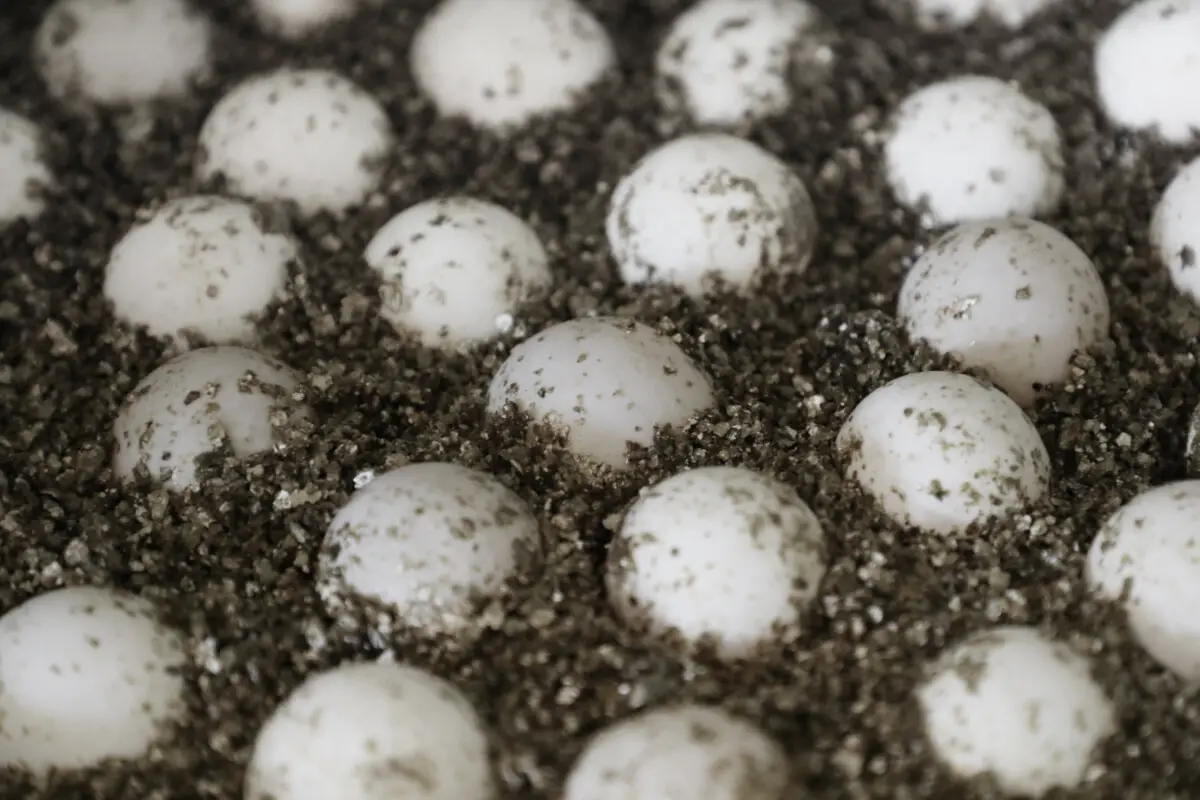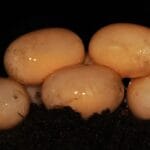Ever wondered how painted turtles, those pretty turtles you see in North America, lay their eggs? Let’s dig deeper into their fascinating egg-laying habits! In this guide, we’ll crack the eggshell on everything you need to know: when they nest, how many eggs they lay, and why their clutches are rather cozy. We’ll also unveil the secrets behind their egg size, shape, and the time it takes for their little turtlets to hatch. Get ready to dive into the world of painted turtle reproduction and learn all there is to know about these captivating creatures!
How Many Eggs Do Painted Turtles Lay?
Painted turtles are like colorful swimmers with their beautiful shells and energetic moves. But did you know that these turtles have some amazing nesting habits? Let’s dive into the secret world of painted turtle egg-laying and find out how many they usually lay.
Egg-Laying Habits
Painted turtles are pretty special when it comes to laying eggs. They usually lay their eggs from April to June, which is when the weather is warm and sunny. To make their nests, they dig little holes in the sand or mud, close to water. They love to find spots that are easy for them to reach and where they feel safe.
Clutch Size
Now, let’s talk numbers. On average, painted turtles lay about 6 eggs in a clutch. But that’s just a general idea. Some turtles might lay a few more, like up to 8, while others might lay a bit less, like 4. The size of the female turtle also makes a difference. Bigger turtles tend to lay more eggs than smaller ones. And as they get older, they might lay even more eggs.
Incubation and Hatching
Once the eggs are snugly in their nest, they stay there for about 60 to 80 days. That’s a lot of waiting! During that time, the temperature of the nest decides when the eggs will hatch and whether the baby turtles will be boys or girls.
Conserving the Turtles
It’s important to remember that the nests and eggs of painted turtles are like little treasures. They need our protection from predators and things that can damage their habitats. If we keep their nesting spots safe, we can help these beautiful creatures thrive for years to come.
Have you ever wondered how long can painted turtles hold their breath? Or what’s the painted turtle egg incubation time? Painted turtles are fascinating creatures with unique adaptations that allow them to survive in their aquatic environment.
How Many Eggs Do Painted Turtles Lay in One Clutch?
Painted turtles, like many other species, go through specific life cycles that include laying eggs. As an egg lover, you might have always wondered about the number of eggs painted turtles lay. Well, grab a comfy seat and let’s dive into the details:
Size Matters
When it comes to egg-laying, size does indeed matter. Larger painted turtles tend to lay more eggs than their smaller counterparts. This is because they have a more spacious “home” inside to accommodate their future little ones. So, if you’re curious about how many eggs a painted turtle might lay, take a peek at its size—it can give you a hint!
The Egg-Laying Season: A Time to Shine
Painted turtles have a specific egg-laying season that spans from mid-April to late June. During this period, they’re busy preparing their nests and getting ready to welcome their offspring into the world.
Clutch Size: A Variety of Choices
Female painted turtles typically lay clutches of 4 to 8 eggs. However, this number can vary depending on the turtle’s size and overall health. Some larger turtles may lay up to 10 eggs, while smaller ones might lay as few as 3.
Physical Characteristics: A Tiny Treat
Painted turtle eggs are quite small, measuring around 1 inch long and 0.75 inches wide. They’re also elliptical in shape and have a beautiful white color.
Incubation: A Delicate Process
Once the eggs are laid, they go through a delicate process called incubation. This usually takes around 70 days, although it can range from 62 to 80 days. During this time, the eggs are carefully nestled in a nest, protected from the elements.
Hatching: A Moment of Joy
After the incubation period, the eggs finally hatch, and tiny painted turtles emerge, ready to explore their world. However, not all eggs make it through this process, and the survival rate can vary depending on factors such as predators and environmental conditions.
Additional Notes:
- Painted turtles can lay multiple clutches during a single egg-laying season.
- The frequency of egg-laying varies among individuals and depends on factors like their age and environment.
- Providing a safe and suitable nesting site can increase the chances of successful egg-laying and hatching.
Why Do Painted Turtles Lay a Relatively Low Number of Eggs?
Painted turtles, the ones with those cool-looking stripes, don’t lay as many eggs as some other turtle species. But there’s a reason for this. It’s all part of their awesome survival strategy.
The Survival Strategy
Imagine you’re a painted turtle mama. You don’t want to put all your eggs in one basket, so to speak. If you lay too many eggs, you risk losing them all to predators or other threats. So instead, you limit your clutch size, usually to around 5-12 eggs. That way, you have a better chance of some of your babies making it to adulthood.
The Threats They Face
Painted turtle eggs have a lot to worry about, these days:
- Nature’s Bounty: Raccoons, skunks, and other egg-loving creatures are just waiting to get their paws on those tasty turtle eggs.
- Human Impact: Habitat loss and egg collection by humans can also put a dent in their numbers.
By keeping their clutch size small, painted turtles reduce the chances of losing their entire future generation to these dangers.
The Bigger Picture
As a species, painted turtles need to keep their population steady. Too many turtles and they start competing for resources and getting into trouble. Too few turtles, and they could disappear altogether. The low egg-laying strategy helps them strike a balance and ensure their long-term survival.
What Else Affects Their Egg-Laying Habits?
It’s not just survival that influences how many eggs a painted turtle lays. Here are a few other factors:
- Size Matters: Bigger turtles tend to lay more eggs because they have more room inside for them.
- Age and Experience: As painted turtles get older and wiser, they may lay larger clutches. They know where to find good nesting spots and have had more practice.
- Nature’s Nods: Things like food and nesting site quality can also play a role in how many eggs a turtle lays.
The Bottom Line
Painted turtles’ low egg-laying strategy is like a carefully crafted puzzle. It’s part of a larger plan to ensure their survival in a world full of challenges. By balancing clutch size with their unique needs, they’ve been able to thrive and paint a beautiful picture of their species’ resilience.
What is the size and shape of painted turtle eggs?
Painted turtles, known for their vibrant markings, produce distinct eggs that play a crucial role in their reproductive cycle. These eggs, though not often seen, are fascinating in their own right. Let’s delve into their unique size and shape:
Size and Shape Characteristics
Painted turtle eggs are typically elliptical, resembling elongated ovals. Their shape is well-suited to accommodate the developing embryo within. The average length of these eggs is about an inch (2.5 cm), while their width measures approximately three-quarters of an inch (1.9 cm). Imagine the size of a small marble, slightly elongated – that’s about the dimension of a painted turtle egg.
Color and Texture
The eggs are predominantly white in color, giving them a clean and pristine appearance. Unlike some turtle species that have hard shells, painted turtle eggs have a soft and leathery texture. This softness allows for flexibility during the incubation period, ensuring the proper development of the embryo.
Clutch Size and Incubation
Painted turtle females lay their eggs in clutches, with the number of eggs varying from 4 to 10. The eggs are usually buried in a carefully chosen nesting site, often in sandy or loose soil. The incubation period lasts approximately 72 to 80 days, during which time the eggs remain nestled in the soil, protected from external elements.
Fertility and Female Influence
Not all eggs laid by painted turtles are fertile. The fertility rate can be influenced by factors such as the age and health of the female turtle. Additionally, larger females tend to lay larger clutches, likely due to the increased internal space available for egg development.
Turtle Conservation
Understanding the size and shape of painted turtle eggs is essential for conservation efforts. By monitoring egg clutches and assessing their viability, researchers can gain valuable insights into the reproductive health of painted turtle populations. Preserving suitable nesting sites and reducing human disturbances ensures the continuation of this fascinating species.
By understanding the unique characteristics of painted turtle eggs, we can appreciate the intricate details of their life cycle and contribute to their preservation for future generations.
FAQ
Q1: When do painted turtles lay their eggs?
A1: Painted turtles lay their eggs during the egg-laying season, which generally runs from mid-April to late June.
Q2: How many eggs do painted turtles lay in one clutch?
A2: Painted turtles typically lay between 4 and 8 eggs per clutch, with an average clutch size of 6.
Q3: Why do painted turtles lay a relatively low number of eggs?
A3: Painted turtles lay a relatively low number of eggs compared to other turtle species due to their reproductive strategy to avoid extinction and maintain a constant population number.
Q4: What is the size and shape of painted turtle eggs?
A4: Painted turtle eggs are white, elliptical in shape, and measure approximately 1 inch long by 0.75 inches wide.
Q5: How long does it take for painted turtle eggs to hatch?
A5: Painted turtle eggs are incubated for 60 to 80 days before hatching.
- Unveiling the Enigma: Mansoureh Khojasteh Bagherzadeh’s Public Appearances & Private Life in Iran - July 18, 2025
- Unveiling the Mystery: Mansoureh Khojasteh Bagherzadeh’s Husband: A Rare Glimpse into a Private Life - July 18, 2025
- Unveiling Masoud Khamenei’s Mother: Power, Influence, and Iran’s Future - July 18, 2025

















Comments are closed.